Why Container Garlic Growing Works for Modern Gardeners
Whether you have limited outdoor space or want to control soil conditions, growing garlic in containers offers surprising advantages. Unlike traditional in-ground methods, container gardening gives you complete control over soil composition, drainage, and pest management. This approach works particularly well for urban gardeners, those with poor native soil, or anyone wanting to extend their growing season by moving pots indoors during extreme weather.
Planning Your Container Garlic Project
Successful container garlic starts with proper planning. The timing of your planting significantly affects your harvest quality and size. In most climates, plant garlic cloves in containers 4-6 weeks before your first expected frost, typically between September and November. This gives roots time to establish before winter dormancy.
| Container Type | Depth Requirement | Drainage Rating | Best For |
|---|---|---|---|
| Plastic pots | 10-12 inches | ★★★★☆ | Cold climates (retains heat) |
| Terra cotta | 10 inches | ★★★☆☆ | Moderate climates |
| Fabric grow bags | 12 inches | ★★★★★ | Hot climates (air pruning) |
| Wood planters | 12+ inches | ★★★☆☆ | Permanent installations |
According to the University of Minnesota Extension, container depth directly impacts bulb size—shallower containers produce smaller bulbs. For optimal results, choose containers with at least 8-10 inches of soil depth below the cloves.
Planting Your Garlic Cloves Correctly
The soil mix you use makes or breaks your container garlic project. Create a blend of 60% potting soil, 30% compost, and 10% perlite for ideal drainage and nutrient balance. Avoid garden soil, which compacts in containers and restricts root growth.
When planting garlic in containers:
- Place cloves with pointed end up, 2-3 inches deep
- Maintain 4-6 inches between cloves in larger containers
- Cover with 2 inches of mulch after planting
- Water thoroughly after planting, then allow top inch to dry

Seasonal Care Timeline for Container Garlic
Understanding the growth stages helps you provide appropriate care throughout the season. The University of California Agriculture and Natural Resources outlines these critical phases:
- Fall (Planting to First Frost): Roots establish while tops grow 2-4 inches
- Winter (Dormancy): Minimal growth; protect from extreme cold
- Early Spring (Regrowth): Apply nitrogen-rich fertilizer as shoots emerge
- Late Spring (Bulb Formation): Water consistently; remove scapes on hardneck varieties
- Early Summer (Harvest Time): When 1/3 of leaves turn brown
Container-grown garlic requires more frequent watering than in-ground plants, especially during bulb formation. Check soil moisture daily in warm weather—containers dry out faster. Water when the top inch of soil feels dry, providing enough to moisten the entire root zone.
Harvesting and Storing Your Container-Grown Garlic
Knowing when to harvest container garlic prevents wasted effort. Unlike in-ground garlic, container plants often mature slightly earlier due to warmer root zones. Watch for these harvest indicators:
- Lower third of leaves turn brown while upper leaves remain green
- Bulb wrappers become papery and distinct
- Individual cloves fill the wrapper skins
To harvest container garlic:
- Stop watering 1-2 weeks before expected harvest
- Gently tip container and loosen soil around bulbs
- Lift entire plant without pulling stems
- Cure in a warm, dry, well-ventilated space for 3-4 weeks
Properly cured container-grown garlic stores just as well as in-ground varieties. The USDA Agricultural Research Service confirms that cured garlic maintains quality for 6-8 months when stored at 60-65°F with 60-70% humidity.
Troubleshooting Common Container Garlic Problems
Container gardening presents unique challenges compared to traditional methods. Here's how to address the most frequent issues:
- Yellowing leaves: Usually indicates overwatering—check drainage and reduce frequency
- Small bulbs: Caused by shallow containers, poor soil, or late planting
- Mold on soil surface: Improve air circulation and avoid wetting foliage
- Frost damage: Move containers against a south-facing wall or cover with frost cloth
Container garlic generally experiences fewer pest problems than in-ground plants, but watch for spider mites in dry conditions. A simple spray of water often resolves minor infestations without chemicals.
Maximizing Flavor in Container-Grown Garlic
The controlled environment of container gardening actually enhances garlic flavor development when managed properly. Research from HortScience Journal shows that consistent moisture during bulb formation increases allicin content—the compound responsible for garlic's characteristic flavor and health benefits.
For the most flavorful container garlic:
- Use organic fertilizers rather than synthetic options
- Avoid excessive nitrogen during bulb formation
- Harvest at precise maturity—not too early or late
- Cure properly before storage











 浙公网安备
33010002000092号
浙公网安备
33010002000092号 浙B2-20120091-4
浙B2-20120091-4